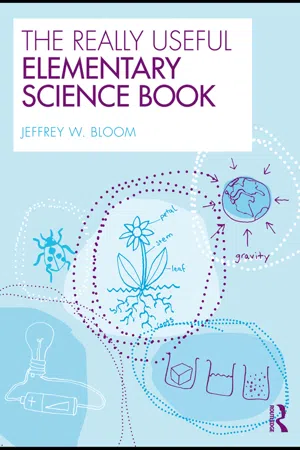Geography
Earth Solar System
The Earth Solar System consists of the Sun, eight planets, their moons, and other celestial objects. Earth is the third planet from the Sun and is the only known planet to support life. The Earth Solar System is located in the Milky Way galaxy and plays a crucial role in sustaining life on our planet.
Written by Perlego with AI-assistance
4 Key excerpts on "Earth Solar System"
Learn about this page
Index pages curate the most relevant extracts from our library of academic textbooks. They’ve been created using an in-house natural language model (NLM), each adding context and meaning to key research topics.
- eBook - ePub
The Really Useful Science Book
A Framework of Knowledge for Primary Teachers
- Steve Farrow, Amy Strachan(Authors)
- 2017(Publication Date)
- Routledge(Publisher)
Without going too deeply into the philosophy of science, it is assumed that all teachers of science would acknowledge the provisional nature of science knowledge, and would endorse the view that what we offer in the way of scientific explanation represents the theory with the current best fit to the observable evidence. The following sections are presented with that thought in mind.CONCEPTS TO SUPPORT KEY STAGES 1 AND 2The solar systemThe Earth is one of eight planets that orbit the Sun. The Sun is a star – a burning ball of gas – that emits light and heat energy as deuterium (heavy hydrogen) atoms fuse to form helium atoms (see Key Idea 4.1 : Nuclear fusion). The planets do not emit light of their own and can be seen because they reflect the light of the Sun from their surfaces.A useful mnemonic for remembering the names of the planets, from the innermost (nearest to the Sun) outwards, is:My Very Energetic Mother Just Served Us NoodlesThe table shows data relating to the solar system.TEACHING IDEA
Children can create their own model solar system using fruit. There may not be a fruit big enough to represent the sun, and so you may have to use a ball.Planet Fruit Mercury Peppercorn Venus Blueberry Earth Grape Mars Pea Jupiter Watermelon Saturn Coconut Uranus Orange Neptune Lemon Distance from Sun (millions of kilometres) Diameter (kilometres) Axial rotation Time for 1 orbit Sun 1,384,000 Mercury 57.9 4,840 59 days 88 days Venus 108.1 12,400 243 days 225 days Earth 149.5 12,742 23 h 56 m 365.25 days Mars 227.8 6,800 24 h 37 m 687 days Jupiter 777.8 142,800 9 h 50 m 11.86 years Saturn 1,426.1 120,800 10 h 14 m 29.45 years Uranus 2,869.1 47,600 10 h 49 m 84.01 years Neptune 4,495.6 44,600 15 h 40 m 165.79 years CONCEPT CONFUSION
It is important to highlight that Pluto is no longer considered a planet, as it does not fit the new criterion of being substantial enough to have cleared its orbit of other larger objects. Pluto is, therefore, considered a dwarf planet.The Sun contains more than 99 per cent of all the matter in the solar system, and it is the mass of the Sun that provides the gravitational force that keeps the planets in their orbits. Each planet describes a more or less elliptical orbit round the Sun, and, with the exception of Pluto, these orbits are all roughly in the same plane. As can be seen from the table, the Earth completes an orbit round the Sun once every 365.25 days. This gives rise to our Earth year of 365 days, with the 0.25 days adding up to the extra day in the leap year, once every 4 years. - eBook - ePub
- Jeffrey W. Bloom(Author)
- 2010(Publication Date)
- Routledge(Publisher)
As we have seen in parts of this section, the Sun’s radiation is the source of energy both for many weather, environmental, and physical processes and for most of life on Earth. However, solar radiation can be problematic. Damage to the ozone layer has damaged our shield against ultraviolet light, which in turn has resulted in increased incidences of skin cancers. In addition, excessive heat can lead to all kinds of unpredictable changes in our environment. We have seen how ocean currents and atmospheric patterns of winds and storms are closely interrelated. At the same time, glaciers and “permanent” snow and ice coverage are important stores in the water cycle. Global warming has been changing the dynamics of the entire global system. Glaciers are melting at unprecedented rates, reducing our water stores, raising sea levels, and changing global oceanic water currents. As a result, these changes can affect weather patterns, storm activity and intensity, such as hurricanes, and global air temperature patterns. Unpredictable extremes in temperatures can occur, where one location may be much hotter than usual, while another is much colder than normal. Some locations may get more flooding, while others endure long droughts.Key Idea 5.6 Earth, Moon, and Solar System
Since early in the history of humankind, people have watched the Sun, Moon, and stars. They described and named constellations. They used these objects for the development of cultural mythologies and for the construction of calendars and clocks. Although some of their understandings were naïve—such as the Earth being at the center of the universe—other understandings were incredibly accurate. These understandings led to systematized agricultural practices, the first calendars and sundials, navigational practices and devices, and a wide variety of cultural practices and mythologies.The Sun as Seen from Earth
In this and other sections, we have seen how important the Sun is to life and to many of the physical processes on Earth. As seen in Figure 5.10 - eBook - ePub
The Theory Of Celestial Influence
Man, The Universe, and Cosmic Mystery
- Rodney Collin(Author)
- 2016(Publication Date)
- Hauraki Publishing(Publisher)
III—THE SOLAR SYSTEM
I—THE LONG BODY OF THE SOLAR SYSTEM
A CONCEIVED BY MAN, THE SOLAR SYSTEM CONSISTS OF A GREAT radiant sphere, round which lie at harmonically increasing intervals, like the ripples round a stone-splash, the orbits through which revolve other smaller and non-radiant spheres. Like the stone in the stone-splash, this central radiant sphere or sun appears the source of the energy by which the whole phenomenon is created. With a diameter perhaps one-ten-thousandth that of its entire system, it stands in almost exactly the same relation to its vast field of influence as does a human ovum to the body which will grow from it. And since in both cases the smaller gives rise to the larger, the concentration or intensity of energy must be of a similar order.The concentric orbits of the dependent spheres or planets are harmonically related according to a law named after Bode. Taking the geometrical development 0, 3, 6, 12, 24, 48, 96, 192 and adding 4 to each figure, we arrive at a series which more or less represents the relative distances of the planetary orbits from the Sun.The planets themselves vary in size—in general increasing from the smallest, Mercury, which is nearest the centre, to the largest, Jupiter, midway between centre and circumference, and then again diminishing to the outermost known planet (Pluto), which is little larger than Mercury.The more remote the planets, the slower their apparent speeds, which diminish from Mercury’s 30 miles a second to Neptune’s 3⅓. This again is a characteristic of the dwindling of impulses sent out from a central source as it plunges ever more deeply into distance. A very good model of the process is provided by a Catherine wheel, which as it spins sends out streams of sparks that appear to curve backwards, away from the direction of the spin—that is, the sparks lose orbital speed the further out they are thrown. - eBook - ePub
Mapping the Psyche Volume 1
The Planets & the Zodiac Signs
- (Author)
- 2016(Publication Date)
- The Wessex Astrologer Ltd(Publisher)
Clare: That’s right. Mesopotamia has always been referred to as the birthplace of western civilisation, and it was here that the art, craft and science of western astrology was first forged. Mesopotamia is a largely flat desert land with wide horizons and huge night skies. It is therefore not surprising that the first myths are often celestial stories or that the heavenly bodies were considered to be deities – living powers whose relationship to human beings was both obvious and taken for granted. Now that we no longer look upwards or watch the planets moving through the night skies we have lost our instinctive connection to these living gods and collectively we have ceased to take astrology seriously. It is sometimes said that the planets have stopped speaking to us because we have stopped listening to them, but if you have ever been in a place far from anywhere and looked up at the night sky, you will have experienced something of the majesty and power of the stars and planets.If there is any spark of imagination left in us, as we stand beneath the stars, trusting the emotions and intuitions that rise up in us, we can feel with bodily certainty that these birds of fire have an impact on human life, an influence that is undeniable.1As students of astrology, one of our first tasks is to get to know and understand the very basic astronomy and mechanics of the solar system. This is the foundation of our art and of our craft and if you can learn this now, it will stand you in good stead throughout your astrological studies. So let’s look at the order of the planets from the Sun. The anatomy of our solar system is not necessarily well understood. But it is extremely important for us, as astrologers, to know, not only because an understanding of the orbit periods of the planets and of their relative speeds is crucial when we come to study the planetary cycles and forecasting techniques, but also because the physical characteristics of the planets tell us a great deal about their astrological meaning.So we see from the following diagram that the orbital periods of the planets depends on their distance from the Sun. The first planet out from the Sun is Mercury, which moves very quickly, with an orbital period of only 88 days. Most of the time Mercury is obscured from view since it is either in front of or behind the Sun. When we do see it, it is only for a brief period as it darts round the outside of the Sun, now one side, now the other. Even the astronomy of the planets can tell us something about their astrological personality. Venus has an orbit of 225 days and has always been known as the Morning Star when it rises with the Sun in the east, and as the Evening Star when it sets with the Sun in the west, representing two faces of this great Goddess. Mercury and Venus are known as ‘inferior’ planets, since their orbits lie inside the orbit of the Earth. Because of this, they appear to accompany the Sun on its annual journey around the birth chart, sometimes ahead of and sometimes lagging behind the Sun, with Mercury never further than 27° and Venus never further than 48° from the Sun.



